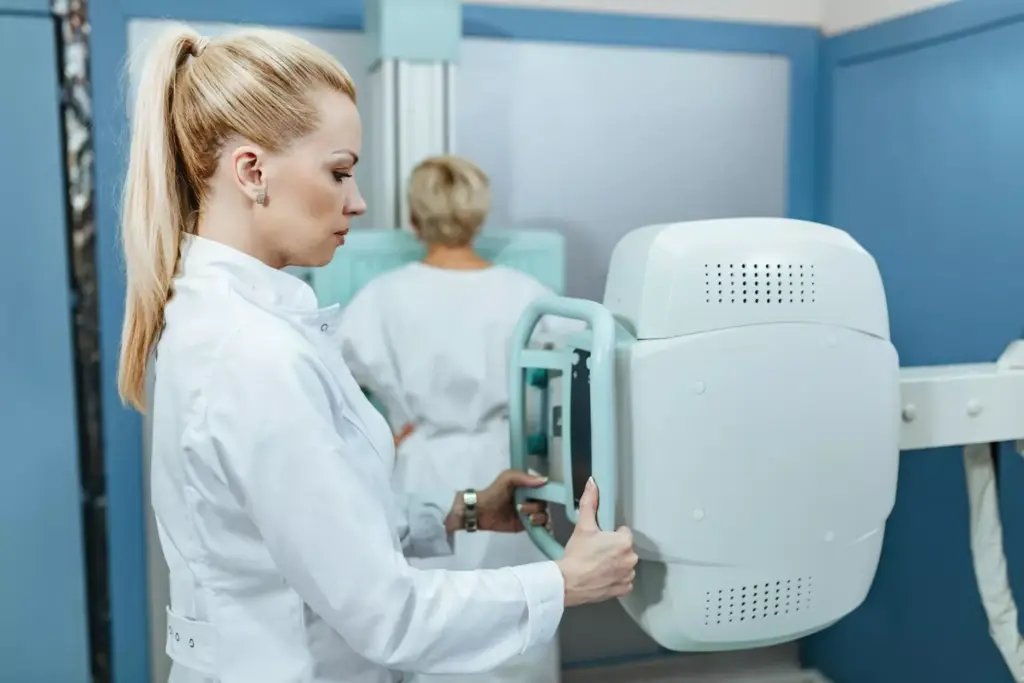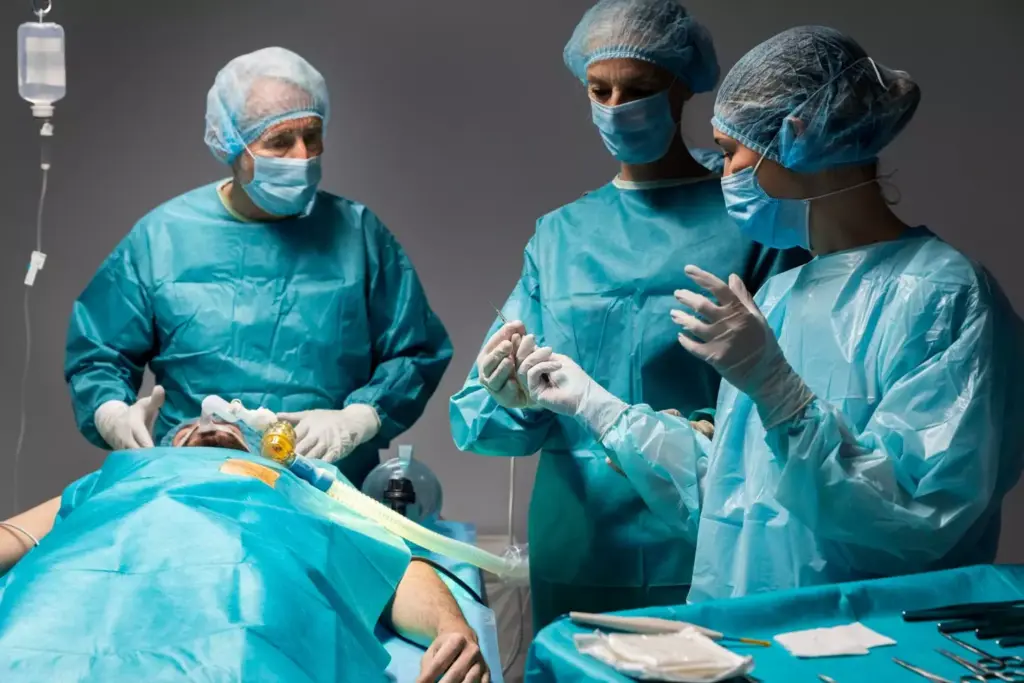Last Updated on November 3, 2025 by mcelik

Finding the right NSCLC treatment can be tough. Liv Hospital focuses on the patient, giving them the best care and newest treatments.
Recent breakthroughs in NSCLC treatment have led to better results for patients. Using immunotherapy with chemotherapy has shown great success, mainly in cancers that can be removed.
It’s important to know about the treatment options available. This article will cover the top 9 NSCLC treatments, including surgery, radiation, and new therapies.

Non Small Cell Lung Cancer (NSCLC) is a complex disease. It’s the most common lung cancer, making up about 85% of cases. Knowing about NSCLC helps pick the best treatment.
NSCLC is divided into three main types: adenocarcinoma, squamous cell carcinoma, and large cell carcinoma. Adenocarcinoma is the most common, often found in non-smokers. It starts in cells that make mucus and is usually in the lung’s outer parts.
Squamous cell carcinoma is linked to smoking and is found more centrally in the lungs. Large cell carcinoma can grow and spread quickly, making it aggressive. NSCLC can also be classified by genetic mutations, which help decide treatment.
Staging NSCLC is key to understanding the prognosis and treatment. It looks at the tumor’s size, lymph node involvement, and if the cancer has spread. The TNM system is commonly used for this.
Accurate staging helps doctors choose the right treatment. This could be surgery, radiation, chemotherapy, targeted therapy, or a mix of these.
A complete diagnosis is vital for understanding a patient’s NSCLC. It involves identifying the cancer type and stage, and analyzing the tumor’s genetics. Biomarker testing can show genetic mutations that certain therapies target.
A detailed diagnostic process ensures patients get treatment plans made just for them. This increases the chance of managing their NSCLC effectively.

Surgical resection is the top treatment for early-stage non-small cell lung carcinoma (NSCLC). It can cure patients if caught early. This method removes the tumor and affected lung tissue, giving patients a good chance of survival.
There are several surgical methods for early-stage NSCLC. The most common is lobectomy, where the whole lung lobe with the tumor is removed. Other options include segmentectomy and wedge resection, which remove smaller parts of the lung.
Each method is chosen based on the tumor’s size, location, and stage, as well as the patient’s health.
Minimally invasive surgeries like video-assisted thoracoscopic surgery (VATS) and robotic-assisted thoracic surgery are gaining popularity. They offer smaller cuts, less pain, shorter hospital stays, and faster recovery times than traditional surgery.
Surgical resection can cure early-stage NSCLC, thanks to early detection. Advances in surgery and care before and after surgery have boosted success rates.
A recent study on a cancer vaccine shows great promise. It could help prevent tumor growth and spread, making surgery even more effective.
Stereotactic Body Radiation Therapy (SBRT) is a top choice for treating early-stage NSCLC that can’t be removed by surgery. It uses precise, high doses of radiation to target tumors. This method helps keep healthy tissues safe.
SBRT is great for those who can’t have surgery because of lung issues or other health problems. It’s appealing because it delivers strong radiation in just a few sessions.
Even though surgery is the first choice for early-stage NSCLC, SBRT is a good option for those who can’t have surgery. Research shows SBRT can work as well as surgery for some patients. Whether to choose SBRT or surgery depends on the patient’s wishes, the tumor, and their health.
| Treatment Modality | Local Control Rate | Survival Rate |
|---|---|---|
| SBRT | 80-90% | 50-60% |
| Surgery | 85-95% | 60-70% |
SBRT has shown great success in controlling tumors for early-stage NSCLC, with success rates up to 90%. Survival rates after SBRT are also good, thanks to the treatment’s effectiveness in frail or sick patients
The results of SBRT for early-stage NSCLC that can’t be removed by surgery are promising. As technology gets better, we can look forward to even better results.
Conventional radiation therapy is key in treating Non-Small Cell Lung Carcinoma (NSCLC). It offers different methods for various stages and patient needs. These methods have evolved, each with its own uses and benefits.
External Beam Radiation Therapy (EBRT) is a common treatment for NSCLC. It uses high-energy beams from outside the body to kill cancer cells. EBRT is highly versatile, treating tumors in different parts of the lungs.
Thanks to new imaging and radiation systems, EBRT has become more precise. This allows doctors to target tumors better while protecting healthy tissues. Image-guided radiation therapy is an example, using images to guide the radiation beams.
Conventional radiation therapy is also used after surgery as an adjuvant treatment. Its goal is to kill any cancer cells left behind. This reduces the chance of cancer coming back.
Adjuvant radiation is often recommended for patients with certain risk factors. These include close or positive margins, or lymph node involvement. It targets microscopic disease, improving local control and survival chances.
For advanced NSCLC, conventional radiation therapy can help. Palliative radiation aims to ease symptoms like pain, cough, or breathing trouble. It reduces tumor size, improving life quality for these patients.
Palliative radiation is given in shorter courses than curative treatments. It’s a good option for patients with limited life expectancy or who can’t handle more aggressive treatments.
Chemotherapy is a key treatment for Non Small Cell Lung Carcinoma (NSCLC). It offers different treatments based on each patient’s needs. It’s used to cure early-stage disease and to help manage symptoms in advanced cases.
Choosing the right first-line chemotherapy for NSCLC depends on several things. These include the disease stage, the patient’s health, and genetic mutations. Platinum-based chemotherapy is often used, sometimes with docetaxel or gemcitabine. Targeted therapies are considered for patients with specific genetic changes.
For advanced NSCLC, combining chemotherapy with targeted therapy can improve survival. Studies show that careful management of medications is key, even in hospice care. This ensures the best quality of life for patients.
Chemotherapy can be given before surgery to make tumors smaller. After surgery, it helps kill any cancer cells left behind. This reduces the chance of cancer coming back.
Chemotherapy is effective but can cause side effects like nausea and hair loss. It’s important to manage these side effects to keep patients’ quality of life good. Advances in supportive care have made chemotherapy more tolerable, allowing patients to stay on treatment.
Managing side effects includes using antiemetic drugs and adjusting doses. Educating patients and providing support are also important. They help patients deal with the challenges of chemotherapy.
Targeted therapy has changed how we treat non-small cell lung carcinoma (NSCLC) with certain genetic mutations. This method uses drugs that target specific genetic changes in cancer cells. It helps stop tumor growth and spread.
EGFR inhibitors are a key part of NSCLC treatment. They block the EGFR tyrosine kinase, which is often mutated in NSCLC patients. EGFR mutations are more common in non-smokers, women, and patients with adenocarcinoma histology.
Drugs like erlotinib, afatinib, and osimertinib are EGFR inhibitors. Osimertinib is effective against EGFR T790M resistance mutations. Using EGFR inhibitors has greatly improved outcomes for NSCLC patients with EGFR mutations.
Other targeted therapies are available for NSCLC patients with different genetic mutations. ALK rearrangements are found in some NSCLC patients. ALK inhibitors like crizotinib, ceritinib, and alectinib have shown significant clinical activity.
ROS1 rearrangements are another genetic alteration in NSCLC. ROS1 inhibitors like crizotinib have shown efficacy. BRAF mutations, though less common, can be targeted with specific inhibitors like dabrafenib.
| Genetic Mutation | Targeted Therapy | Examples of Drugs |
|---|---|---|
| EGFR mutation | EGFR inhibitors | Erlotinib, Afatinib, Osimertinib |
| ALK rearrangement | ALK inhibitors | Crizotinib, Ceritinib, Alectinib |
| ROS1 rearrangement | ROS1 inhibitors | Crizotinib |
| BRAF mutation | BRAF inhibitors | Dabrafenib |
Despite their initial success, targeted therapies often face resistance over time. This limits their long-term effectiveness. To overcome this, new targeted therapies and combination regimens are being developed.
For example, osimertinib targets EGFR T790M resistance mutations. Next-generation ALK inhibitors like alectinib and brigatinib also show activity against ALK-resistant mutations.
Combining targeted therapies with chemotherapy or immunotherapy is another approach. This is being explored to delay or overcome resistance.
Immunotherapy is a new hope for NSCLC patients. It uses the body’s immune system to fight cancer cells. This approach is groundbreaking.
Checkpoint inhibitors have changed immunotherapy. They target proteins on T cells or cancer cells. This lets the immune system attack cancer cells better.
Key checkpoint inhibitors include pembrolizumab, nivolumab, and atezolizumab. Studies show they improve survival and slow cancer growth in NSCLC patients.
Finding biomarkers for immunotherapy is key. PD-L1 expression is a top biomarker. Higher levels mean better response to treatments.
Other biomarkers like tumor mutational burden (TMB) and microsatellite instability (MSI) are being studied. They could help choose the best treatments.
Immunotherapy has great benefits but also side effects. These side effects, or irAEs, can be mild or severe. They can affect the skin, gut, and endocrine system.
Effective management of irAEs is vital. It ensures patient safety and improves treatment results. Early recognition and prompt treatment are key.
Understanding and managing irAEs helps patients get the most from immunotherapy. Healthcare providers play a big role in this.
Combination treatment strategies are changing how we fight advanced NSCLC. They offer new hope to patients. By mixing different treatments, doctors can make plans that fit each patient’s needs. This could lead to better results.
Chemoimmunotherapy combinations are showing great promise for advanced NSCLC. Combining chemotherapy with immunotherapy has better results than chemotherapy alone. This is because chemotherapy makes tumor cells more visible to the immune system.
A study found that these combinations improve survival and stop cancer from growing. For more on NSCLC treatment, check out Regeneron’s press release on their work.
For locally advanced NSCLC, doctors use surgery, radiation, and systemic therapy together. Multimodality treatment attacks the tumor from all sides. This way, it tackles both local and systemic disease.
Choosing the right order of treatments is key. It depends on the tumor’s stage, the patient’s health, and biomarkers. By planning treatments carefully, doctors can get the best results and reduce side effects.
Figuring out the best order of treatments is complex. Treatment sequencing aims to get the most out of treatments while keeping side effects low.
In summary, combining treatments is a big step forward in fighting advanced NSCLC. Chemoimmunotherapy and multimodality approaches help doctors create personalized plans. This leads to better outcomes for patients.
New treatments are giving hope to those with NSCLC. Advances in tech and research have brought new therapies. These are being tested to see if they can help patients more.
Tumor Treating Fields (TTFields) is a non-invasive therapy. It uses electric fields to stop cancer cells from dividing. TTFields has been shown to be effective in treating certain types of cancer, including NSCLC.
It works by applying electric fields to the tumor. This stops cancer cells from growing and dividing.
A study found that TTFields with chemotherapy improved survival in advanced NSCLC patients.
“The addition of TTFields to standard chemotherapy represents a significant advancement in the treatment of NSCLC,” said a leading oncologist.
| Treatment Modality | Mechanism of Action | Clinical Benefit |
|---|---|---|
| Tumor Treating Fields | Disrupts cancer cell division | Improved overall survival |
| Photodynamic Therapy | Destroys cancer cells with light | Local control of tumors |
Photodynamic Therapy (PDT) uses a light-sensitive compound to kill cancer cells. When light hits the compound, it reacts with oxygen to kill cancer cells. PDT is being explored for its use in treating both early-stage and advanced NSCLC.
PDT is good for early-stage NSCLC patients who can’t have surgery. For advanced disease, it can help by shrinking tumors and easing symptoms.
New treatments are being tested in clinical trials for NSCLC. These include targeted therapies, immunotherapies, and new combinations. These trials help find out if these treatments are safe and work well.
Patients with NSCLC should talk to their doctors about clinical trials. These trials might offer new treatments not yet available to everyone.
Personalized medicine is changing how we treat metastatic non-small cell lung cancer (NSCLC). It makes treatments fit each patient’s needs. New technologies like genomic profiling and liquid biopsy help doctors give better care.
Comprehensive genomic profiling (CGP) is a key tool in personalized medicine. It finds the genetic changes that cause NSCLC in each patient. This helps doctors pick the best treatments. New software makes CGP even more useful in treating cancer.
| Benefit | Description |
|---|---|
| Identification of Targetable Mutations | CGP finds specific genetic changes that therapies can target. |
| Improved Treatment Selection | Knowing a patient’s genetic changes helps doctors choose the best treatment. |
| Enhanced Patient Outcomes | CGP leads to better results by matching treatments to each patient’s tumor. |
Liquid biopsy analyzes blood for tumor DNA. It’s great for checking how treatments work and finding new mutations. This lets doctors make changes to treatment plans quickly, helping patients more.
Doctors now consider more than just the tumor’s genetics. They look at the patient’s health, preferences, and lifestyle too. This makes treatment plans that really fit each person’s needs.
Dealing with NSCLC treatment options can be tough. But, the newest treatments bring hope to patients and their families. We’ve looked at the top 9 NSCLC treatment options, showing there are many ways to fight the disease.
There’s a wide range of treatments, from surgery and radiation to targeted and immunotherapy. This variety means doctors can tailor treatments to each patient. This personalized care is key to managing NSCLC well, as it considers each patient’s unique situation and cancer type.
As treatments for NSCLC keep getting better, it’s important to stay up-to-date. Knowing about the latest treatments and working with healthcare providers helps patients make smart choices. To navigate NSCLC treatment well, patients need to understand the disease and the treatments available.
The main types of non-small cell lung carcinoma (NSCLC) are adenocarcinoma, squamous cell carcinoma, and large cell carcinoma.
NSCLC is staged by looking at the tumor size, lymph nodes, and if it has spread. Knowing the stage helps decide the best treatment and what to expect.
Surgery is the top choice for early-stage NSCLC, aiming for a cure. The surgery type depends on where and how big the tumor is.
SBRT is a non-surgical radiation therapy that gives high doses to the tumor. It’s for early-stage NSCLC that can’t be removed by surgery or for those not good candidates for surgery.
Chemotherapy kills cancer cells and is used in many ways. It can be the first treatment, before surgery, or after. The choice and length of treatment depend on the tumor’s stage and type.
Targeted therapy attacks specific genetic changes in the tumor. It’s for NSCLC patients with certain genetic mutations, like EGFR or ALK.
Immunotherapy uses the body’s immune system to fight cancer. It’s used for NSCLC and includes treatments like PD-1/PD-L1 inhibitors.
Using treatments together, like chemotherapy and immunotherapy, can improve results and survival for advanced NSCLC patients.
Personalized medicine tailors treatment to each patient, considering genetic mutations and tumor details. Tests like genomic profiling and liquid biopsy help make these decisions.
New treatments for NSCLC include tumor treating fields and photodynamic therapy. These are being tested in clinical trials.
Treating metastatic NSCLC involves a team effort, including chemotherapy, targeted therapy, immunotherapy, and care for symptoms. Treatment plans are made based on the patient’s situation and tumor details.
Palliative care is key in NSCLC treatment, focusing on managing symptoms, pain, and improving life quality for those with advanced disease.
National Cancer Institute (NCI). Non-Small Cell Lung Cancer Treatment (PDQ). https://www.cancer.gov/types/lung/patient/non-small-cell-lung-treatment-pdq
NCBI. PMC article. https://pmc.ncbi.nlm.nih.gov/articles/PMC10047909/
Translational Lung Cancer Research (TLCR). Research Article. https://tlcr.amegroups.org/article/view/8139/html
Cancer Research UK. Treatment for non-small cell lung cancer. https://www.cancerresearchuk.org/about-cancer/lung-cancer/treatment/non-small-cell-lung-cancer
Subscribe to our e-newsletter to stay informed about the latest innovations in the world of health and exclusive offers!
WhatsApp us